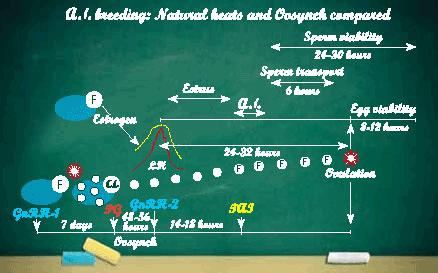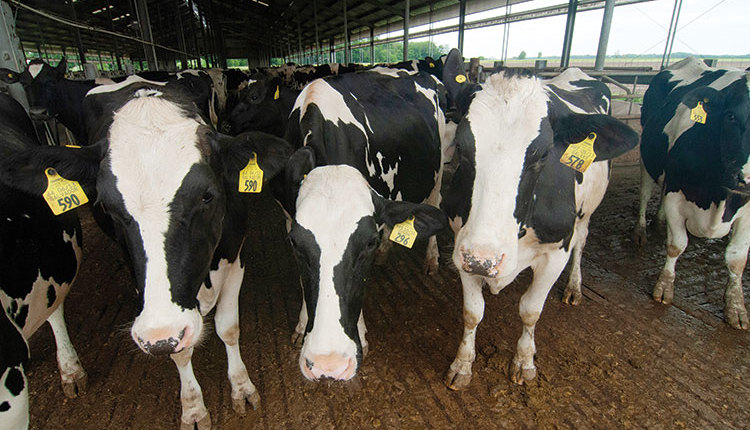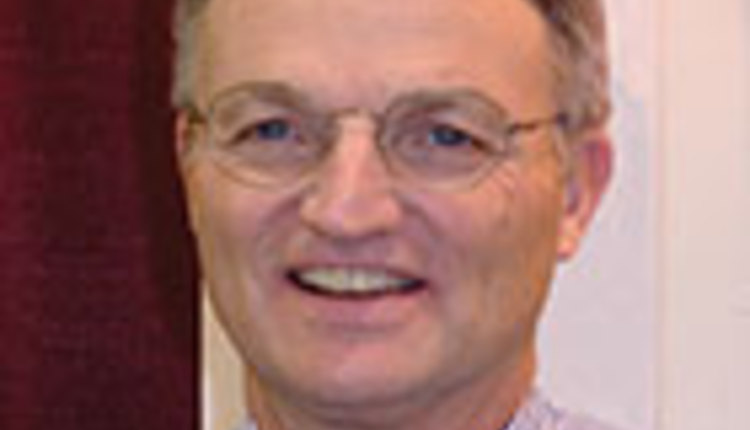The author is professor of animal sciences at Kansas State University, Manhattan.
Welcome to A.I. breeding 101 - a virtual college class held here today! We have come a long way since the 1970s when fixed-time A.I. was first attempted in our industry.
In those days, prostaglandin F2? (PG) was our only tool to induce heats in cows and heifers. It is no wonder that pregnancy outcomes were very poor because we did not know what we know today. The variation in when heat occurs during five days after PG injections is now attributable to our understanding how follicles grow and mature and their relationship to regression of the corpus luteum (CL).
We can now manipulate the estrous cycle very effectively in both cows and heifers. Those who work with dairy producers in an effort to improve the management of reproduction in herds of varying sizes endeavor to teach correct principles so their application will result in more timely pregnancies. Because we hear of some "odd" variations and misapplication of these correct principles, it is important that we review the basics that apply to A.I. breeding of cows.
In my October 10, 2011, column "The ins and outs of synch programs" on page 638, I addressed some of the reasons why and when we use gonadotropin-releasing hormone in these programs. GnRH has many forms: 2 cc of either Cystorelin, Factrel, Fertagyl, or OvaCyst; while PG consists of 2 cc of Estrumate or estroPLAN, or 5 cc of Lutalyse or Prostamate. Let's review how the Ovsynch program relates to what occurs when a cow comes into heat spontaneously.
Natural heat
The figure (upper portion) illustrates events associated with a natural heat. A cow or heifer that comes into heat spontaneously is responding to a complex number of hormonal cues. A maturing follicle (F) in the absence of a functional CL in the ovary produces sufficient estrogen (broken yellow line) to induce behavioral changes in the cow. These include depressed appetite, nervousness, sniffing, butting, chin resting, vaginal mucous discharge, uterine contractions, mounting, and standing heat. As blood estrogen peaks, it triggers release of GnRH from the hypothalamus which, in turn, induces the surge release of the ovulatory hormone, luteinizing hormone (LH, solid red line) from the pituitary gland.
This long, sustained release of LH occurs during 8 to 12 hours and is initiated at or just after the peak in blood estrogen. Estrogen induces heat activity, physiological changes in the reproductive tract, and other behavioral changes. However, it is the LH surge that initiates the chain of functional processes in the mature pre-ovulatory follicle which result in ovulation of one or two follicles in approximately 24 to 32 hours.
Correct timing of insemination of cows in natural heat necessitates that semen placement occur mid- to late-estrus. REMEMBER: timing of ovulation is related to the onset of heat and does not seem to be associated with the duration of heat. Duration of heat is quite variable. It tends to be shorter in cows producing more milk, but considerably longer in replacement heifers than in lactating cows.
Following the time-proven a.m.-p.m. rule of A.I. breeding, inseminations should occur approximately 12 hours after first detected heat. This proven rule of thumb relies on diligent, twice daily observations of all cows eligible for insemination. By adhering to this rule of thumb, semen is placed in the uterine body approximately 12 to 20 hours before ovulation occurs.
During this period, sperm are transported to the junction of the uterine horns and the oviducts, forming a reservoir there while awaiting ovulation of the egg. It is also during this period that sperm undergo physical and biochemical changes that prepare them to fertilize the egg, including capacitation and the acrosomal reaction that is the final preparatory step for fertilization. Note that viability of the sperm is much longer than that of the egg.

Timed A.I.
I have illustrated the Ovsynch timed A.I. program in the bottom portion of the figure. The first part of Ovsynch (GnRH-1 and PG seven days later) generally prepares a new follicle for ovulation after PG. In more than 60 percent of cows, GnRH-1 induces a follicle to ovulate and form a new, or another, CL. Some of the cows have a CL at GnRH-1 (cows having normal estrous cycles), but some may not (anovulatory cows) as shown in the illustration. As a result of GnRH-1, one or more CL may be present in the ovaries at the time of PG injection.
Note the similarities in how the final part of the Ovsynch program aligns with the events described previously for a cow in natural heat. The GnRH-2 injection aligns with the onset of estrus. The GnRH-2 injection's role is to induce the LH surge in the same way that higher estrogen levels were the trigger for the LH surge leading to ovulation in 24 to 32 hours for a cow having a natural heat. Timing of insemination in the Ovsynch program after GnRH-2 is analogous to insemination after the onset of estrus as determined by the a.m.-p.m. rule.
Coordinated events
In summary, for natural or hormone-induced ovulation, spontaneous events or intervening injections are timed properly to maximize the opportunity for fertilization and continued normal pregnancy. Following correct principles leads to success. Much of these guiding principles have been discovered by dedicated scientists engaged in discovery and application research around the world. Let's leave the experimentation to them and profit thereby.
Click here to return to the Reproduction E-Sources
120510_336
In those days, prostaglandin F2? (PG) was our only tool to induce heats in cows and heifers. It is no wonder that pregnancy outcomes were very poor because we did not know what we know today. The variation in when heat occurs during five days after PG injections is now attributable to our understanding how follicles grow and mature and their relationship to regression of the corpus luteum (CL).
We can now manipulate the estrous cycle very effectively in both cows and heifers. Those who work with dairy producers in an effort to improve the management of reproduction in herds of varying sizes endeavor to teach correct principles so their application will result in more timely pregnancies. Because we hear of some "odd" variations and misapplication of these correct principles, it is important that we review the basics that apply to A.I. breeding of cows.
In my October 10, 2011, column "The ins and outs of synch programs" on page 638, I addressed some of the reasons why and when we use gonadotropin-releasing hormone in these programs. GnRH has many forms: 2 cc of either Cystorelin, Factrel, Fertagyl, or OvaCyst; while PG consists of 2 cc of Estrumate or estroPLAN, or 5 cc of Lutalyse or Prostamate. Let's review how the Ovsynch program relates to what occurs when a cow comes into heat spontaneously.
Natural heat
The figure (upper portion) illustrates events associated with a natural heat. A cow or heifer that comes into heat spontaneously is responding to a complex number of hormonal cues. A maturing follicle (F) in the absence of a functional CL in the ovary produces sufficient estrogen (broken yellow line) to induce behavioral changes in the cow. These include depressed appetite, nervousness, sniffing, butting, chin resting, vaginal mucous discharge, uterine contractions, mounting, and standing heat. As blood estrogen peaks, it triggers release of GnRH from the hypothalamus which, in turn, induces the surge release of the ovulatory hormone, luteinizing hormone (LH, solid red line) from the pituitary gland.
This long, sustained release of LH occurs during 8 to 12 hours and is initiated at or just after the peak in blood estrogen. Estrogen induces heat activity, physiological changes in the reproductive tract, and other behavioral changes. However, it is the LH surge that initiates the chain of functional processes in the mature pre-ovulatory follicle which result in ovulation of one or two follicles in approximately 24 to 32 hours.
Correct timing of insemination of cows in natural heat necessitates that semen placement occur mid- to late-estrus. REMEMBER: timing of ovulation is related to the onset of heat and does not seem to be associated with the duration of heat. Duration of heat is quite variable. It tends to be shorter in cows producing more milk, but considerably longer in replacement heifers than in lactating cows.
Following the time-proven a.m.-p.m. rule of A.I. breeding, inseminations should occur approximately 12 hours after first detected heat. This proven rule of thumb relies on diligent, twice daily observations of all cows eligible for insemination. By adhering to this rule of thumb, semen is placed in the uterine body approximately 12 to 20 hours before ovulation occurs.
During this period, sperm are transported to the junction of the uterine horns and the oviducts, forming a reservoir there while awaiting ovulation of the egg. It is also during this period that sperm undergo physical and biochemical changes that prepare them to fertilize the egg, including capacitation and the acrosomal reaction that is the final preparatory step for fertilization. Note that viability of the sperm is much longer than that of the egg.

Timed A.I.
I have illustrated the Ovsynch timed A.I. program in the bottom portion of the figure. The first part of Ovsynch (GnRH-1 and PG seven days later) generally prepares a new follicle for ovulation after PG. In more than 60 percent of cows, GnRH-1 induces a follicle to ovulate and form a new, or another, CL. Some of the cows have a CL at GnRH-1 (cows having normal estrous cycles), but some may not (anovulatory cows) as shown in the illustration. As a result of GnRH-1, one or more CL may be present in the ovaries at the time of PG injection.
Note the similarities in how the final part of the Ovsynch program aligns with the events described previously for a cow in natural heat. The GnRH-2 injection aligns with the onset of estrus. The GnRH-2 injection's role is to induce the LH surge in the same way that higher estrogen levels were the trigger for the LH surge leading to ovulation in 24 to 32 hours for a cow having a natural heat. Timing of insemination in the Ovsynch program after GnRH-2 is analogous to insemination after the onset of estrus as determined by the a.m.-p.m. rule.
Coordinated events
In summary, for natural or hormone-induced ovulation, spontaneous events or intervening injections are timed properly to maximize the opportunity for fertilization and continued normal pregnancy. Following correct principles leads to success. Much of these guiding principles have been discovered by dedicated scientists engaged in discovery and application research around the world. Let's leave the experimentation to them and profit thereby.
120510_336










